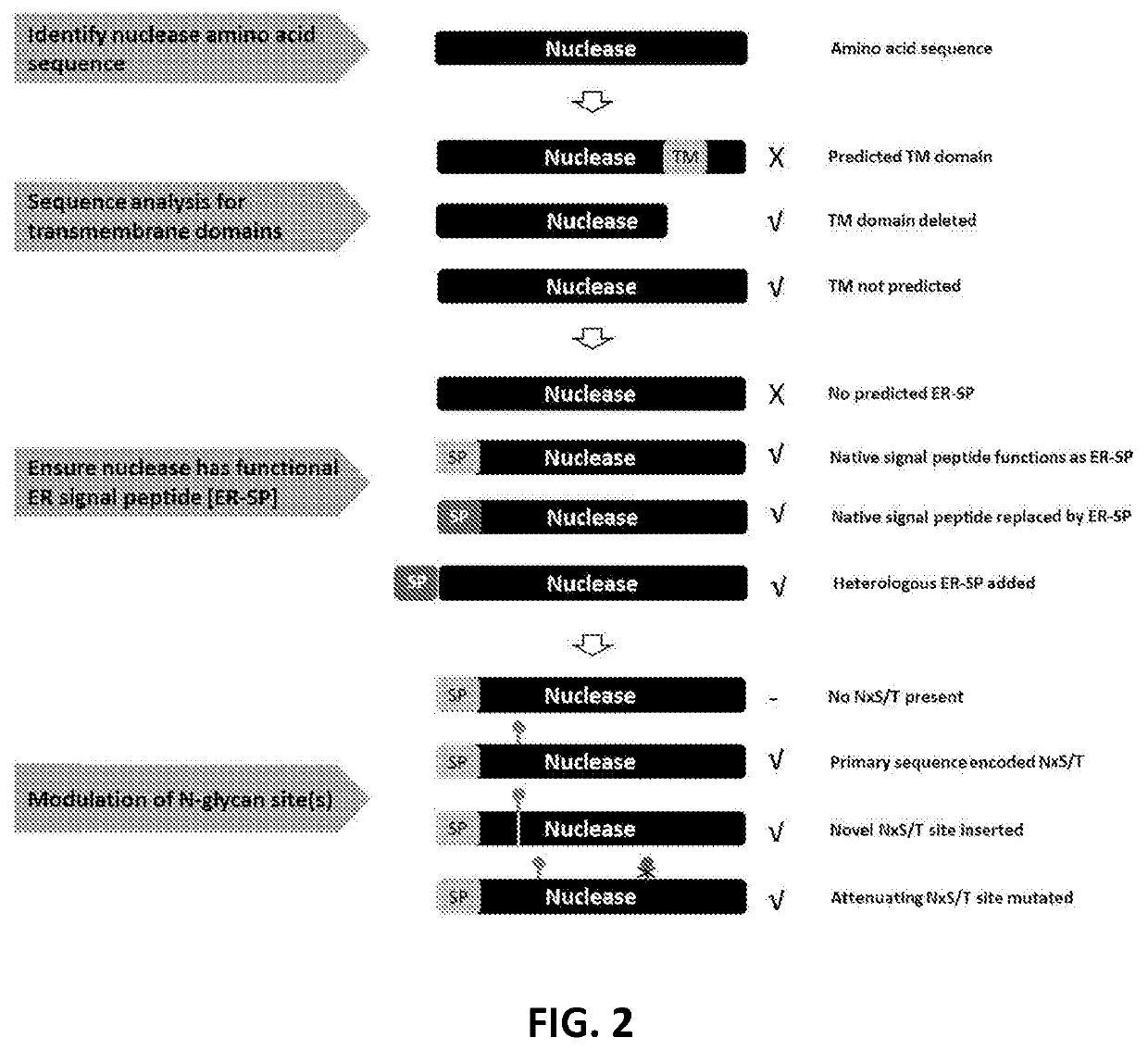Viral vector production system
a production system and virus technology, applied in the field of viral vector production system, can solve the problems of high cost of transfection agent/plasmid and/or process agent, inability to produce further generations of infective virus, high cost of transient transfection process, etc., and achieve the effect of high efficiency and streamlined process
- Summary
- Abstract
- Description
- Claims
- Application Information
AI Technical Summary
Benefits of technology
Problems solved by technology
Method used
Image
Examples
example 1
n Constructs Encoding Widely Divergent Nucleases for the Reduction of Residual DNA During Viral Vector Production Cell Culture
[0468]Expression plasmids were constructed for Serratia marcescens Endonuclease A (SmNucA), VsEndA and BacNucB according to FIG. 3. All constructs contained the SV40 promoter and polyadenylation signal. ORFs were codon-optimised (Homo sapiens) and were 6×Histidine tagged at their C-terminus (H6). SmNucA expression plasmids encoded wild type smNucA with its own bacterial secretory sequence or had its bacterial secretory sequence replaced with that of human Albumin or VSV-G, or additionally included N×S / T sequon mutations at the stated positions. VsEndA or VcEndA expression plasmids encoded wild type nuclease with its own bacterial secretory sequence or had its bacterial secretory sequence replaced with that of human Albumin, or additionally included N×S / T sequon mutations at T121V, N130D, S135R. BacNucB expression plasmids encoded wild type BacNucB with its ow...
example 2
tion of Expression and Secretion of a Nuclease from HEK293T Cells Correlated with Reduced Residual DNA in Culture Media
[0469]HEK293T cells were transfected with a fixed amount of plasmid DNA (total μg) using different ratios of stuffer DNA (pBluescript) and pSV40-smNucAH6, which encodes SmNucA fused with a C-terminal His-tag to allow for protein detection. Cell lysates and culture media were analysed by immunoblotting to the His-tag (an endogenous His-tagged protein TRAPH6′ was used as a loading control), which demonstrated that SmNucAH6 was expressed and secreted in the cultures in a dose-dependent manner. Clarified culture supernatants were analysed for residual DNA by PicoGreen assay, which demonstrated that reduction in DNA detection only occurred in the presence of SmNucAH6 in the media. Results are shown in FIG. 4.
example 3
l Histidine Tagged and Untagged Secreted Nucleases During Production of Lentiviral Vector Production
[0470]HIV-1 based lentiviral vectors were produced by transient co-transfection of secreted nuclease plasmids into either adherent or suspension HEK293T cells at 10% input of total pDNA. Lentiviral vector harvests were left ‘untreated’ or were treated with Benzonase® for 1 hour prior to clarification. Secreted nuclease cultures were not treated with Benzonase®. Filtered culture media was analysed by PicoGreen assay. Secreted nucleases produced equivalent or better DNA reduction than Benzonase® in culture media. Results are shown in FIG. 5.
PUM
 Login to View More
Login to View More Abstract
Description
Claims
Application Information
 Login to View More
Login to View More - R&D
- Intellectual Property
- Life Sciences
- Materials
- Tech Scout
- Unparalleled Data Quality
- Higher Quality Content
- 60% Fewer Hallucinations
Browse by: Latest US Patents, China's latest patents, Technical Efficacy Thesaurus, Application Domain, Technology Topic, Popular Technical Reports.
© 2025 PatSnap. All rights reserved.Legal|Privacy policy|Modern Slavery Act Transparency Statement|Sitemap|About US| Contact US: help@patsnap.com



